Page 756 - The Toxicology of Fishes
P. 756
736 The Toxicology of Fishes
Much of this testing is focused on aquatic invertebrates and fish. Increasingly more complex tests are
conducted in each tier, moving from simple acute tests to chronic to full life cycle. At each tier, data
are evaluated and an estimate of potential risk to the aquatic environment is determined. Based on the
outcomes of testing at each tier, the decision is made whether to stop testing or continue to the next tier.
The final tier (Tier IV) involves field testing (AEDG, 1992). Registrants may be required by the EPA
to conduct higher tiered tests or may voluntarily opt for this level of testing to refute the presumption
of unacceptable environmental risk indicated by a lower tiered test. Generally, the fourth tier of testing
has been viewed as tests to demonstrate that the chemical exposure, under more realistic environmental
conditions, may not be as severe as expected under laboratory “clean-water” exposures. In effect, the
fourth tier looks at how the chemicals dissipate, metabolize, hydrolyze, photolyze, and disperse and to
where they ultimately move.
Prior to the adoption by the EPA of the mesocosm testing as part of the ecological risk assessment
of pesticides, Tier IV tests were conducted in natural systems exposed to the agricultural chemical during
the course of typical farming practices. Whereas these types of studies provided realism in terms of
environmental fate of the compound and exposure to the aquatic ecosystem, they were difficult to
evaluate, in part, because of insufficient or no replication, a high degree of variability associated with
the factors being measured and influences of uncontrollable events such as weather. In the mid-1980s,
the EPA adopted the use of mesocosms (experimental ponds) as surrogate natural systems in which
ecosystem-level effects of pesticides could be measured (Tier IV tests) and included in the ecological
risk assessment process (Touart, 1988). Although no longer part of the regulatory requirements in the
United States, mesocosm tests requirements have stimulated an increased worldwide interest in the use
of surrogate ecosystems for the evaluation of the fate and effects of contaminants in aquatic ecosystems
as evidenced by the number of symposia and guidelines (Campbell et al., 1999; Giddings et al., 2002;
Graney et al., 1994; Hill, et al., 1994a; SETAC–Europe, 1991; SETAC and RESOLVE, 1991).
Biomagnification
One of the best uses of enclosures or mesocosms for fish studies is to learn aspects of contaminant
bioaccumulation into top predators. Barron (1995) presented an overview of biomagnification principles
and determinants in aquatic food webs. Biomagnification is the increase in contaminant body burden
caused by contaminant transfer from lower to higher trophic levels (Thomann et al., 1992). Rasmussen
et al. (1990) showed that polychlorinated biphenyls (PCBs) in lake trout (Salvelinus namaycush)
increased with length of the benthic-based food web and with tissue lipid content. Bioaccumulation into
other keystone species, not necessarily just fish, has also been studied. Simon et al. (2000) analyzed the
trophic transfer of cadmium and methylmercury between the Asiatic clam (Corbicula fluminea) and
crayfish (Astacus astacus). Their results suggest a small risk of cadmium transfer between crayfish and
predators, including fish and humans; however, methylmercury distribution in muscle and its consequent
bioaccumulation in predators present an obvious risk.
Model Ecosystems
A wide variety of model ecosystems have been developed and used for fundamental and applied aquatic
ecological research. Review articles describing these systems are available for microcosms (Giddings,
1980), freshwater mesocosms (Hill et al., 1994a; Solomon and Liber, 1988), marine mesocosms (Gearing,
1989; Grice, 1982; Lalli, 1990), and artificial streams (Kennedy et al., 1995).
Microcosms
Microcosms have been employed extensively in studies of contaminant effects on community-level
structure and function. These systems can be viewed as an intermediate to laboratory tests and larger
scale mesocosms. Microcosms, whether indoor or outdoor, may not accurately parallel natural systems
at all levels of organization, but important processes such as primary productivity and community

